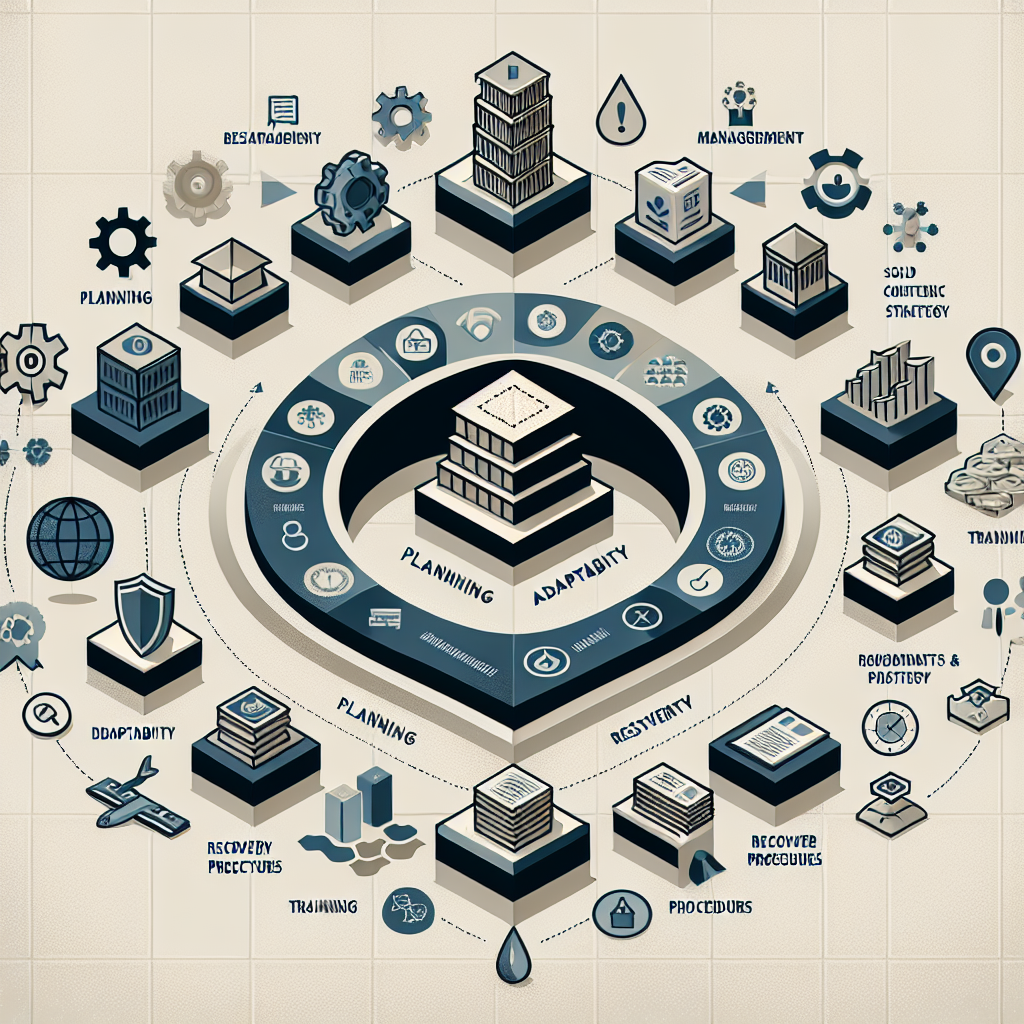Your cart is currently empty!
Tag: Components

Key Components of a Successful Business Continuity Strategy
In today’s fast-paced and unpredictable business environment, it is essential for companies to have a solid business continuity strategy in place. This strategy helps organizations to prepare for and recover from potential disruptions, such as natural disasters, cyber attacks, or other emergencies, minimizing the impact on operations and ensuring business continuity.There are several key components that are essential for a successful business continuity strategy. These components are crucial for ensuring that a company can effectively respond to and recover from disruptions, maintaining operations and minimizing downtime.
1. Risk Assessment: The first step in developing a business continuity strategy is conducting a thorough risk assessment. This involves identifying potential risks and vulnerabilities that could impact the business, such as natural disasters, supply chain disruptions, or cyber threats. By understanding these risks, companies can develop strategies to mitigate them and ensure business continuity.
2. Business Impact Analysis: Once risks have been identified, it is important to conduct a business impact analysis. This involves assessing the potential impact of disruptions on key business processes and functions. By understanding the potential consequences of disruptions, companies can prioritize their response efforts and allocate resources effectively.
3. Business Continuity Plan: A business continuity plan is a comprehensive document that outlines the steps to be taken in the event of a disruption. This plan should include strategies for responding to emergencies, communication protocols, and recovery procedures. It should also outline roles and responsibilities for key personnel and specify resources needed to implement the plan.
4. Communication Plan: Effective communication is essential during a crisis situation. A communication plan should outline how information will be shared with employees, customers, suppliers, and other stakeholders during a disruption. This plan should include contact information for key personnel, communication channels to be used, and protocols for updating stakeholders on the status of operations.
5. Testing and Training: It is important to regularly test and update the business continuity plan to ensure its effectiveness. This may involve conducting tabletop exercises or simulations to practice response procedures and identify areas for improvement. Additionally, employees should receive training on their roles and responsibilities during a crisis to ensure a coordinated and effective response.
6. Continual Improvement: Business continuity planning is an ongoing process that requires continual assessment and improvement. Companies should regularly review and update their strategies in response to changing risks and business needs. This may involve updating the risk assessment, revising the business impact analysis, or refining response procedures based on lessons learned from previous incidents.
In conclusion, a successful business continuity strategy is essential for ensuring that companies can effectively respond to and recover from disruptions. By incorporating key components such as risk assessment, business impact analysis, a business continuity plan, communication plan, testing and training, and continual improvement, organizations can enhance their resilience and minimize the impact of disruptions on their operations. Investing in a robust business continuity strategy is crucial for safeguarding the continuity and success of a business in today’s volatile business environment.

Key Components of a Successful Service Level Agreement (SLA)
A Service Level Agreement (SLA) is a crucial document that outlines the expectations and responsibilities of both parties in a service provider-client relationship. A well-crafted SLA can help ensure that both parties are on the same page and can help prevent misunderstandings and disputes down the line. Here are some key components of a successful SLA:1. Service Description: The SLA should clearly outline the services that will be provided by the service provider. This includes a detailed description of the scope of work, the expected deliverables, and any limitations or exclusions.
2. Service Level Objectives (SLOs): SLOs define the expected level of service that the provider will deliver. This may include metrics such as uptime, response times, and resolution times. SLOs should be realistic and measurable to ensure that both parties can track performance and hold each other accountable.
3. Performance Metrics: It is important to include specific performance metrics in the SLA that will be used to measure the provider’s performance. This may include metrics such as availability, response time, resolution time, and customer satisfaction. These metrics should be clear, objective, and easily measurable.
4. Responsibilities and Duties: The SLA should clearly outline the responsibilities and duties of both parties. This includes the responsibilities of the service provider in delivering the services, as well as the responsibilities of the client in providing necessary information and access. Clear delineation of responsibilities can help prevent misunderstandings and ensure that both parties are aware of their obligations.
5. Escalation Procedures: In the event of a service issue or dispute, it is important to have clear escalation procedures in place. This may include a hierarchy of contacts, a process for escalating issues, and timelines for resolution. Having clear escalation procedures can help ensure that issues are addressed in a timely manner and that both parties are on the same page.
6. Service Level Credits: In the event that the service provider fails to meet the agreed-upon SLOs, the SLA should outline the process for issuing service level credits. This may include a formula for calculating credits, timelines for issuing credits, and any limitations on credits. Service level credits can help incentivize the provider to meet their obligations and compensate the client for any service failures.
In conclusion, a successful SLA should be clear, comprehensive, and measurable. By including key components such as service description, SLOs, performance metrics, responsibilities, escalation procedures, and service level credits, both parties can ensure a successful and productive working relationship. A well-crafted SLA can help set expectations, prevent misunderstandings, and ensure that both parties are working towards a common goal.

10 Key Components of a Successful Service Level Agreement
A Service Level Agreement (SLA) is a crucial document that outlines the expectations and responsibilities between a service provider and a client. This agreement sets the standards for the services to be provided and ensures that both parties are on the same page regarding performance and quality. In order for an SLA to be successful, there are 10 key components that should be included:1. Scope of Services: The SLA should clearly define the services that will be provided by the service provider. This includes the specific tasks, deliverables, and timelines that are expected.
2. Service Level Objectives: This section outlines the performance metrics that will be used to measure the service provider’s performance. This could include metrics such as uptime, response time, and resolution time.
3. Responsibilities: The SLA should clearly define the responsibilities of both parties. This includes the duties of the service provider, as well as any obligations that the client must fulfill in order to receive the services.
4. Service Availability: This section outlines the hours of operation and availability of the services. It should also include any planned maintenance windows or downtime that may occur.
5. Performance Monitoring: The SLA should include details on how performance will be monitored and reported. This could include regular reports, dashboards, or other tracking mechanisms.
6. Escalation Procedures: In the event that there is a service issue or dispute, the SLA should outline the escalation procedures that will be followed. This could include contact information for key stakeholders or a process for resolving disputes.
7. Service Level Credits: Some SLAs include provisions for service level credits in the event that performance falls below the agreed-upon standards. This section outlines how credits will be calculated and applied.
8. Change Management: The SLA should include a process for managing changes to the services or the agreement itself. This could include a change request process or a formal review period for updates.
9. Termination Clause: In the event that either party wishes to terminate the agreement, there should be a clear clause outlining the process for doing so. This could include notice periods or other requirements.
10. Signatures: Finally, the SLA should be signed by both parties to indicate their agreement to the terms and conditions outlined in the document. This provides a legal framework for the agreement and ensures that both parties are committed to following the terms.
In conclusion, a successful Service Level Agreement should include these 10 key components to ensure that both parties are clear on their expectations and responsibilities. By defining the scope of services, setting performance metrics, outlining responsibilities, and including provisions for issue resolution and termination, an SLA can help to establish a strong and successful partnership between a service provider and a client.

Key Components of a Service Level Agreement: What You Need to Know
A Service Level Agreement (SLA) is a key document that outlines the terms and conditions of the services provided between a service provider and a client. It serves as a contract that sets expectations, responsibilities, and metrics for performance. Understanding the key components of an SLA is crucial for both parties to ensure a successful partnership.1. Service Description: The SLA should clearly define the scope of services provided by the service provider. This includes a detailed description of the services, any exclusions, and the expected outcomes.
2. Service Level Objectives (SLOs): SLOs are specific goals and targets for service performance. This includes metrics such as uptime, response time, and resolution time. SLOs should be measurable and realistic.
3. Service Level Indicators (SLIs): SLIs are the key performance indicators used to measure the service provider’s performance. These indicators should be clearly defined and agreed upon by both parties.
4. Responsibilities: The SLA should outline the responsibilities of both the service provider and the client. This includes tasks, obligations, and expectations for each party.
5. Escalation Procedures: In the event of a service disruption or failure, the SLA should include escalation procedures for resolving issues. This includes contact information, response times, and escalation paths.
6. Reporting and Review: The SLA should specify how performance will be monitored, measured, and reported. This includes regular review meetings, performance reports, and any necessary adjustments to the SLA.
7. Remedies and Penalties: The SLA should outline remedies and penalties for breaches of the agreement. This includes compensation for service failures, termination clauses, and dispute resolution processes.
8. Change Management: The SLA should include procedures for managing changes to the services, such as upgrades, modifications, or enhancements. This includes how changes will be communicated, approved, and implemented.
9. Termination Clause: The SLA should include a termination clause that outlines the conditions under which the agreement can be terminated. This includes notice periods, reasons for termination, and any associated fees or penalties.
In conclusion, understanding the key components of a Service Level Agreement is essential for both service providers and clients to establish a successful partnership. By clearly defining expectations, responsibilities, and metrics for performance, an SLA helps ensure that both parties are on the same page and can effectively manage their relationship. By including these key components in the SLA, both parties can work together to achieve their goals and objectives.

Key Components of a Strong Service Level Agreement
A Service Level Agreement (SLA) is a key component of any business relationship, outlining the expectations and responsibilities of both parties. A strong SLA is essential for ensuring that the services provided meet the needs and expectations of the customer. In order to create a strong SLA, there are several key components that should be included.1. Scope of Services: The first component of a strong SLA is a clear definition of the services that will be provided. This should include a detailed description of the services, as well as any limitations or exclusions. It is important to clearly outline what is included in the services and what is not, in order to avoid any misunderstandings or disputes later on.
2. Service Level Objectives: Service Level Objectives (SLOs) are specific, measurable goals that define the level of service that will be provided. These can include metrics such as response times, uptime, and performance levels. It is important to establish realistic and achievable SLOs in order to ensure that both parties are clear on what is expected.
3. Reporting and Monitoring: A strong SLA should include provisions for reporting and monitoring the services provided. This may include regular reporting on key performance indicators, as well as monitoring of service levels in real-time. By including reporting and monitoring provisions in the SLA, both parties can ensure that the services are meeting the agreed-upon standards.
4. Escalation Procedures: In the event that there is a service issue or dispute, it is important to have clear escalation procedures in place. These procedures should outline the steps that will be taken to resolve the issue, as well as the timeline for resolution. By including escalation procedures in the SLA, both parties can ensure that any issues are addressed in a timely and efficient manner.
5. Service Level Credits: Service Level Credits are a common provision in SLAs, providing compensation to the customer in the event that the service levels are not met. These credits can take the form of discounts on future services or refunds for services that were not provided as agreed. By including service level credits in the SLA, both parties can ensure that there are consequences for failing to meet the agreed-upon service levels.
In conclusion, a strong SLA is essential for ensuring that the services provided meet the needs and expectations of the customer. By including key components such as a clear scope of services, service level objectives, reporting and monitoring provisions, escalation procedures, and service level credits, both parties can establish a strong foundation for their business relationship. By taking the time to create a comprehensive SLA, businesses can ensure that their services are delivered in a consistent and reliable manner.

Building a Strong Foundation: Key Components of a Successful Business Continuity Plan
A business continuity plan is a crucial component of any successful organization. It outlines the steps and procedures necessary to ensure that a business can continue to operate in the face of disruptions, whether they be natural disasters, cyber attacks, or other unforeseen events. Building a strong foundation for a business continuity plan involves identifying key components that are essential for its success.One key component of a successful business continuity plan is risk assessment. This involves identifying potential threats to the organization and assessing their likelihood and potential impact. By understanding the risks facing the business, organizations can develop strategies to mitigate them and ensure that they are prepared for any eventuality.
Another important component of a business continuity plan is business impact analysis. This involves identifying critical business functions and processes, as well as the resources and dependencies that support them. By understanding the impact of disruptions to these functions, organizations can prioritize their recovery efforts and allocate resources effectively.
Communication is also a key component of a successful business continuity plan. In the event of a disruption, clear and effective communication is essential to ensure that all stakeholders are informed and that decisions can be made quickly. Organizations should have a communication plan in place that outlines how information will be shared internally and externally during a crisis.
Training and testing are also essential components of a business continuity plan. All employees should be trained on their roles and responsibilities in the event of a disruption, and regular testing should be conducted to ensure that the plan is effective and up to date. By regularly testing the plan, organizations can identify any gaps or weaknesses and make the necessary improvements.
Finally, a successful business continuity plan should be regularly reviewed and updated. As the business environment evolves and new risks emerge, organizations must ensure that their plan remains relevant and effective. Regular reviews and updates will help to ensure that the plan continues to meet the needs of the organization and remains a valuable tool for maintaining business continuity.
In conclusion, building a strong foundation for a business continuity plan involves identifying key components that are essential for its success. By conducting risk assessments, performing business impact analyses, establishing clear communication channels, providing training and testing, and regularly reviewing and updating the plan, organizations can ensure that they are prepared for any disruption that may come their way. Investing the time and resources in developing a robust business continuity plan is essential for the long-term success and resilience of any organization.

Key Components of a Successful Help Desk System
A help desk system is an essential tool for any organization looking to provide efficient and effective customer support. It serves as a central point of contact for customers to report issues, ask questions, and seek assistance with products or services. A successful help desk system is one that is well-designed, user-friendly, and equipped with key components that enhance its functionality and effectiveness. In this article, we will discuss the key components of a successful help desk system.1. Ticketing System: A ticketing system is the backbone of any help desk system. It allows support agents to track, prioritize, and resolve customer issues in a systematic and organized manner. When a customer submits a request for help, a ticket is created, and it contains all the relevant information about the issue, such as the customer’s contact details, the nature of the problem, and any previous interactions with the customer. This ensures that no issue falls through the cracks and that each customer receives timely and appropriate assistance.
2. Knowledge Base: A knowledge base is a repository of articles, FAQs, troubleshooting guides, and other resources that provide customers with self-service options for common issues. By empowering customers to find answers to their questions on their own, a knowledge base can help reduce the volume of support tickets and improve the overall efficiency of the help desk system. It also allows support agents to focus on more complex and high-priority issues, ultimately leading to faster resolution times and higher customer satisfaction.
3. Automation Tools: Automation tools can help streamline and optimize the help desk process by automating repetitive tasks, such as ticket routing, response generation, and follow-up reminders. By using automation tools, help desk agents can save time, reduce human error, and improve the overall speed and efficiency of the support process. For example, automated ticket routing can ensure that each ticket is assigned to the most appropriate agent based on their skills and availability, while automated response generation can provide customers with instant acknowledgment of their request.
4. Reporting and Analytics: Reporting and analytics tools are essential for monitoring the performance of the help desk system and identifying areas for improvement. By tracking key metrics, such as ticket volume, resolution times, customer satisfaction scores, and agent productivity, organizations can gain valuable insights into the effectiveness of their support operations. This data can be used to identify trends, pinpoint bottlenecks, and make informed decisions about resource allocation and process optimization.
5. Integration Capabilities: A successful help desk system should be able to integrate seamlessly with other tools and systems used within the organization, such as CRM software, project management tools, and communication platforms. This integration allows for a more holistic view of the customer and their interactions with the organization, enabling support agents to provide more personalized and efficient assistance. It also allows for the seamless exchange of information between different departments, leading to a more cohesive and collaborative approach to customer support.
In conclusion, a successful help desk system is one that is equipped with key components that enhance its functionality and effectiveness. By implementing a ticketing system, knowledge base, automation tools, reporting and analytics capabilities, and integration capabilities, organizations can provide efficient and effective customer support that leads to higher customer satisfaction and loyalty. Investing in a robust help desk system is essential for any organization looking to deliver exceptional customer service and build long-lasting relationships with their customers.

Preparing for the Unexpected: Key Components of a Disaster Recovery Plan
Disasters can strike at any time, and it’s crucial for businesses to be prepared for the unexpected. A solid disaster recovery plan can mean the difference between a minor inconvenience and a major catastrophe. In this article, we will discuss the key components of a disaster recovery plan that every business should have in place.First and foremost, it’s essential to have a comprehensive understanding of the potential risks that your business faces. This could include natural disasters such as hurricanes, earthquakes, or floods, as well as man-made disasters like cyber attacks, power outages, or equipment failures. By identifying these risks, you can better prepare for them and mitigate their impact on your business.
One of the most important components of a disaster recovery plan is a communication strategy. In the event of a disaster, it’s crucial to be able to quickly and effectively communicate with employees, customers, and other stakeholders. This could involve setting up a phone tree, creating a designated communication team, or utilizing social media and other digital platforms to keep everyone informed.
Another key component of a disaster recovery plan is data backup and recovery. In today’s digital age, data is often one of the most valuable assets that a business has. It’s essential to regularly back up your data and store it in a secure location, such as the cloud or an off-site server. In the event of a disaster, being able to quickly recover and restore your data can help minimize downtime and keep your business running smoothly.
Additionally, it’s important to have a plan in place for maintaining business operations during and after a disaster. This could involve establishing alternative work locations, setting up remote access for employees, or outsourcing critical functions to third-party providers. By having a plan in place for how your business will continue to operate in the aftermath of a disaster, you can minimize the impact on your bottom line and ensure the continuity of your operations.
Finally, it’s crucial to regularly test and update your disaster recovery plan. As your business grows and evolves, so too will the risks that it faces. By regularly reviewing and testing your disaster recovery plan, you can identify any weaknesses or gaps in your preparedness and make the necessary adjustments to ensure that your business is fully protected.
In conclusion, preparing for the unexpected is a critical aspect of running a successful business. By having a comprehensive disaster recovery plan in place that addresses key components such as risk assessment, communication, data backup and recovery, business continuity, and regular testing and updates, you can better protect your business from the unforeseen and ensure its long-term success.

Understanding the Key Components of a Service Level Agreement
A Service Level Agreement (SLA) is a key document that outlines the expectations and responsibilities between a service provider and a client. It is a crucial component of any business relationship, as it helps to ensure that both parties are clear on what is expected and how performance will be measured. Understanding the key components of an SLA is essential for both service providers and clients to ensure a successful partnership.One of the most important components of an SLA is the scope of services. This section outlines the specific services that will be provided by the service provider, as well as any limitations or exclusions. It is important for both parties to have a clear understanding of what is included in the agreement to avoid any misunderstandings or disagreements down the line.
Another key component of an SLA is the service levels and performance metrics. This section outlines the expected level of performance for each service provided, as well as the metrics that will be used to measure performance. These metrics could include response times, uptime percentages, and resolution times. By clearly defining these metrics, both parties can ensure that expectations are aligned and that performance can be accurately measured.
The SLA should also include details on how performance will be monitored and reported. This could include regular reports on performance metrics, as well as procedures for escalating and resolving any performance issues. By establishing clear monitoring and reporting processes, both parties can stay informed on the status of the services provided and address any issues in a timely manner.
In addition, an SLA should include details on the responsibilities and obligations of both parties. This could include details on payment terms, maintenance responsibilities, and any other obligations that each party must fulfill. By clearly outlining these responsibilities, both parties can ensure that they are meeting their obligations and upholding their end of the agreement.
Finally, an SLA should include details on dispute resolution and termination procedures. This section outlines the steps that will be taken in the event of a dispute between the parties, as well as the procedures for terminating the agreement. By establishing clear procedures for resolving disputes and terminating the agreement, both parties can ensure that they have a plan in place in case things don’t go as planned.
In conclusion, understanding the key components of a Service Level Agreement is essential for both service providers and clients to ensure a successful partnership. By clearly defining the scope of services, service levels and performance metrics, monitoring and reporting processes, responsibilities and obligations, and dispute resolution and termination procedures, both parties can ensure that expectations are aligned and that the agreement is being upheld. By taking the time to understand and outline these key components, both parties can establish a strong foundation for a successful business relationship.

Key Components of IT Infrastructure Management
IT infrastructure management is the process of overseeing the operational aspects of an organization’s information technology (IT) infrastructure. This includes managing hardware, software, networks, and data storage to ensure that they are running efficiently and effectively. To successfully manage IT infrastructure, there are key components that need to be taken into consideration.1. Hardware Management: Hardware management involves monitoring and maintaining the physical components of an organization’s IT infrastructure, such as servers, computers, and networking equipment. This includes ensuring that hardware is up-to-date, properly configured, and functioning correctly. Hardware management also involves tracking inventory, managing warranties, and planning for future hardware upgrades.
2. Software Management: Software management involves overseeing the installation, configuration, and maintenance of software applications used within an organization. This includes ensuring that software licenses are up-to-date, managing software updates and patches, and troubleshooting any software-related issues that may arise. Software management also involves monitoring software usage to ensure compliance with licensing agreements and security policies.
3. Network Management: Network management involves monitoring and maintaining the organization’s network infrastructure, including routers, switches, firewalls, and wireless access points. This includes ensuring that the network is secure, reliable, and performing optimally. Network management also involves monitoring network traffic, identifying and resolving network issues, and planning for network expansion or upgrades as needed.
4. Data Storage Management: Data storage management involves overseeing the organization’s data storage infrastructure, including servers, storage arrays, and backup systems. This includes managing data backups, ensuring data security and integrity, and optimizing data storage performance. Data storage management also involves planning for data growth, implementing data retention policies, and ensuring compliance with data privacy regulations.
5. Security Management: Security management involves implementing and maintaining security measures to protect the organization’s IT infrastructure from cyber threats and unauthorized access. This includes implementing firewalls, antivirus software, intrusion detection systems, and encryption technologies. Security management also involves monitoring security logs, conducting security audits, and responding to security incidents in a timely manner.
Overall, effective IT infrastructure management requires a comprehensive approach that addresses all of these key components. By proactively managing hardware, software, networks, data storage, and security, organizations can ensure that their IT infrastructure is reliable, secure, and able to support their business operations effectively. Investing in IT infrastructure management is essential for organizations to stay competitive in today’s digital age.
